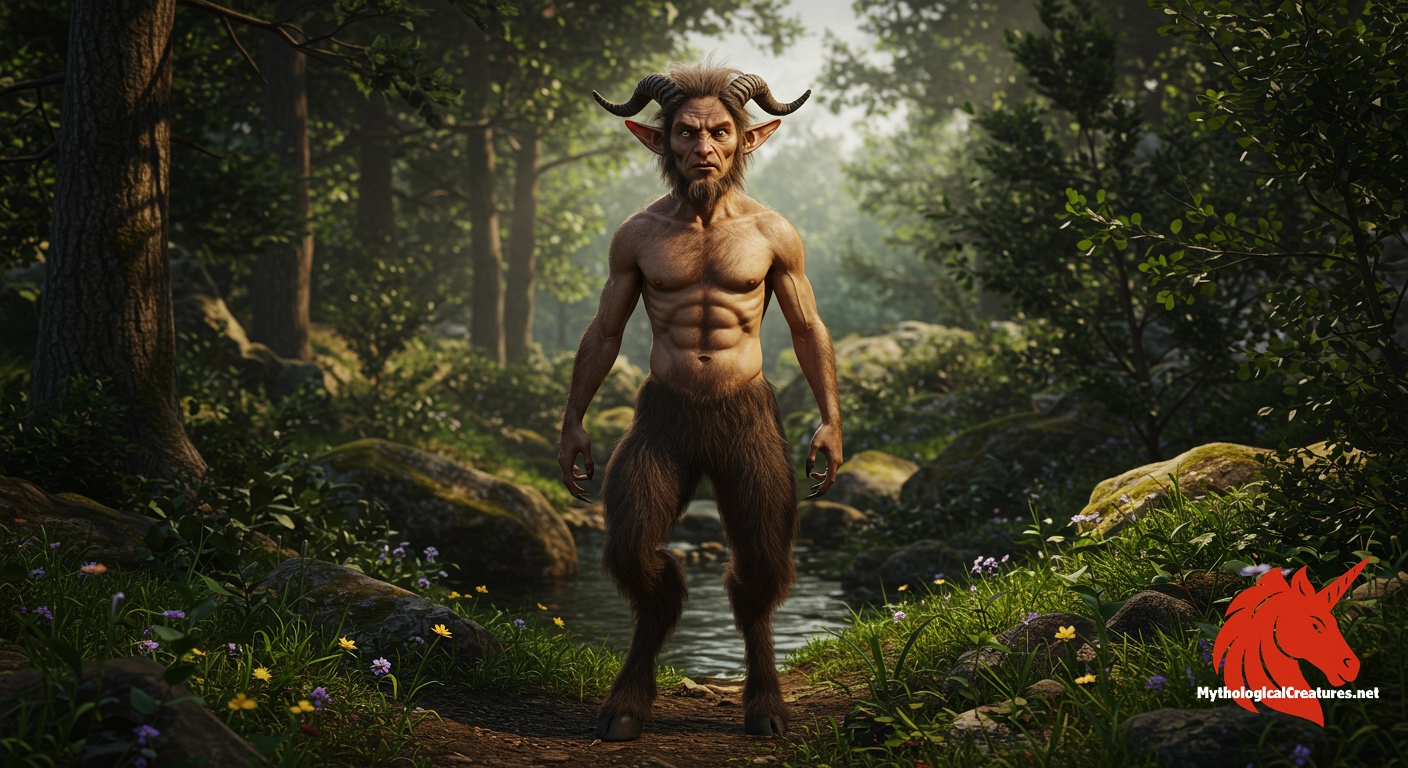Satyr: Satyrs are male nature spirits from Greek mythology renowned for their lascivious and ribald behaviour.

Satyr
Satyr - Symbolises the uninhibited, chaotic, and carnal aspects of nature and celebration in ancient Greek culture.
Origins & First Encounters
Satyrs have long been emblematic figures in Greek mythology, representing a wild fusion of nature and divine revelry. Their origins can be traced back to some of the earliest artistic and literary depictions, where they were intimately associated with Dionysus and the spirit of the untamed wilderness. They emerged in myth as male nature spirits whose characteristics blended human intelligence with raw, bestial energy. Early depictions show them with animalistic features such as equine ears and tails, symbolising a direct connection to the natural world. As myth evolved, satyrs came to embody both comic mischief and a primal, unbridled sensuality. Their roles in ritualistic celebrations and dramatic performances underscored a cultural fascination with the interplay between order and chaos. They were integrated into myths that celebrated the excesses of life, often serving as foils to both the gods and mortal protagonists. Artistic and literary accounts from ancient Greece established the satyr as a figure that could simultaneously provoke laughter and unease. Over time, their image was layered with symbolism that spoke to both human folly and nature’s indomitable force. Ultimately, the satyr remains a vivid reminder of the delicate balance between civilisation and the wild unknown.
Source Texts & Tale Variants
Ancient literature and dramatic works provide a rich tapestry of sources that bring the satyr to life. The sole surviving complete satyr play, Cyclops by Euripides, offers a singular insight into the raucous and bawdy spirit that these beings embodied in theatre. Fragments of Sophocles’s Ichneutae further support the depiction of satyrs as both mischievous companions and disruptive forces in myth. Various vase paintings and sculptures from archaic Greece also lend visual evidence to their roles in festive and ritual contexts. Alongside these classical texts, local oral traditions contributed diverse narratives that expanded on the satyr’s escapades and peculiar wisdom. Different regions produced their own versions, some emphasising their lustful antics while others highlighted a hidden sagacity that could be coaxed from them. The character of Silenus, for example, appears in multiple accounts as both a merry wanderer and a wise tutor to the young Dionysus. Alternate story variants even recount the satyrs’ encounters with nymphs and mortals in a way that underscored their unpredictable nature. Such stories reveal a multifaceted portrayal that spans both the comic and the tragic. In every instance, ancient sources cemented the satyr’s place as a dynamic figure whose narrative was as fluid as the wine they so adored.
Form & Powers
Satyrs are vividly depicted with a compelling fusion of human and animal characteristics that render them both enchanting and uncanny. Early representations frequently show them with equine features such as elongated ears and a distinctive tail, which immediately evoke images of wild, unbridled energy. Their depictions often include a permanently exaggerated state of arousal, a detail that symbolises their hyperactive sexuality and lustful impulses. In many works of art, satyrs are portrayed with a rough, shaggy mane of hair and faces that blend human expression with bestial features like snub noses and large, expressive eyes. As artistic conventions evolved, later images began to incorporate goat-like characteristics, such as slender horns and cloven hooves, which further blurred the line between man and beast. Their naked, robust forms are rendered with a raw, earthy quality, emphasising a life lived in the embrace of nature rather than the confines of civilisation. Some depictions show them as diminutive and sprightly, while others emphasise a sturdier, more muscular physique that hints at physical strength. The deliberate cobbling together of human and animal elements was not merely decorative, but also a visual metaphor for the tension between order and chaos. Each detail—whether it be the flowing hair, the expressive eyes, or the hybrid limbs—serves to reinforce the satyr’s reputation as both an agent of uninhibited indulgence and a keeper of secret natural wisdom. The meticulous physical portrayal of the satyr continues to invite viewers to reflect on the complexities of desire, freedom, and the primal essence inherent in all beings.
Regional Faces
The image of the satyr evolved considerably as it travelled beyond its original Greek milieu, adapting to the local customs and myths of various regions. In classical Greece, satyrs were portrayed as wild, drunken followers of Dionysus, embodying the spirit of unrestrained festivity and natural chaos. As these myths spread through the Mediterranean, the raw exuberance of the satyr was softened in Roman adaptations, where they were reinterpreted as the more benign and pastoral fauns. This transformation was further refined in Medieval and Renaissance art, where satyr-like figures often coexisted with other archetypal nature spirits. In Italy and other parts of Europe, indigenous traditions merged with classical imagery, rendering these beings as protectors of rustic landscapes and symbols of fertility. Some regions emphasised their trickster qualities, presenting them as both mischievous and wise in local folklore. Asian Minor and Eastern Mediterranean traditions sometimes depict similar woodland sprites with subtle variations in facial features or dress, reflecting regional stylistic choices. The changes in depiction often mirrored the cultural values and societal norms of the area, whether emphasising debauchery, pastoral innocence, or even a nurturing relationship with nature. In this way, the satyr functioned as a kind of mythological chameleon, adapting gracefully to the varied cultural and artistic demands of each locale. Despite these regional nuances, the essential duality of wild passion and hidden erudition remained a consistent feature throughout its evolution.
Cultural Parallels
A comparative analysis reveals that the satyr shares striking similarities with a range of mythological creatures across various cultures. The Roman faun is perhaps the most obvious analogue, sharing not only physical attributes but also a gentler, more pastoral association that contrasts with the more exaggerated licentiousness traditionally ascribed to the satyr. In Northern Europe, woodland sprites and other rustic nature spirits echo the satyr’s role as a mediator between human civilisation and the wild. Comparable to the trickster archetypes found in many indigenous traditions, the satyr embodies qualities of both humour and mischief that transcend specific cultural boundaries. Early mythologies often use hybrid figures like the satyr to symbolise the liminal space between order and chaos—a theme that resonates universally. Similar dualities appear in other cultural symbols, where the blurring of human and animal traits serves as a metaphor for the untamed forces in nature. The recurring motif of a creature who is both erudite and lecherous underscores a shared human fascination with dual identities and the interplay of opposites. Comparative studies thus illuminate a wider tapestry of myth in which the satyr occupies a unique yet interconnected space alongside other nature spirits. This cross-cultural dialogue reinforces the idea that the themes embodied by the satyr—wildness, revelry, and the untamed aspects of desire—are virtually invariant across diverse myth-making traditions. In essence, the satyr serves as a multifaceted symbol whose influence can be traced in various folklore and myth systems around the globe.
Legacy & Modern Evolution
The historical evolution of the satyr reflects a significant transformation from a scandalously lewd wilderness spirit to a more refined emblem of nature and pastoral innocence. In antiquity, satyrs were celebrated for their unrestrained debauchery and wild, anarchic energy—a stark contrast to the ordered lives of ancient civilisation. The Renaissance marked a turning point where artists began to reimagine the satyr, integrating elements of classical beauty and restrained sensuality with the untamed features of the original myth. This dual nature was further explored during the Enlightenment, when satyrs were sometimes depicted in a more allegorical light that emphasised the interplay between civilisation and nature. In modern fantasy literature and art, satyrs have largely shed their raw obscenity in favour of a more whimsical, even friendly, presence, often rebranded as fauns. Today, they appear as figures that straddle the line between mythic mischief and benign natural guardians, appealing to both adult sensibilities and children's imaginations. Contemporary interpretations often explore the satyr as a metaphor for the unbridled creativity and instinctual impulses that still stir within modern society. Films, video games, and fantasy novels continue to reinvent these characters, ensuring their enduring presence in the cultural imagination. Although their portrayal has become considerably tamer over time, the enduring essence of the satyr as a symbol of the untamed and the irrational remains intact. Consequently, the satyr's legacy is a testament to the timeless human desire to explore and reconcile the wild, often contradictory, facets of existence.
Interesting Fact
An interesting observation about satyrs is their transformation over time, from wild, ribald nature spirits in ancient Greece to gentler, whimsical figures in Renaissance art, highlighting the evolving perceptions of myth and morality.
For serious mythcraft
Your project belongs among the legends
If your work deepens how people understand, play with, or teach mythology, a sponsor placement here keeps it in front of the right readers all year.
Submit a sponsorship enquiryQuick Creature Info
Type:
Origin:
Features:
Associations:
Our Mythic Legendary Rating:

Also Sometimes Known As:
Habitat:
Physical Attributes:
Abilities:
Behavior:
Weaknesses:
Lore:
References
Discover Another Mythical Legend You May Not Have Heard Of?
Uncover the mysteries of ancient folklore and expand your knowledge of legendary beings from cultures around the world.
Dare to Meet the Akaname....
Curated by the Mythological Creatures Team
Series editor: Mythological Creatures Directory
Primary desk: Hellenic & Ancient Mediterranean Desk
(rev. November 2025)
